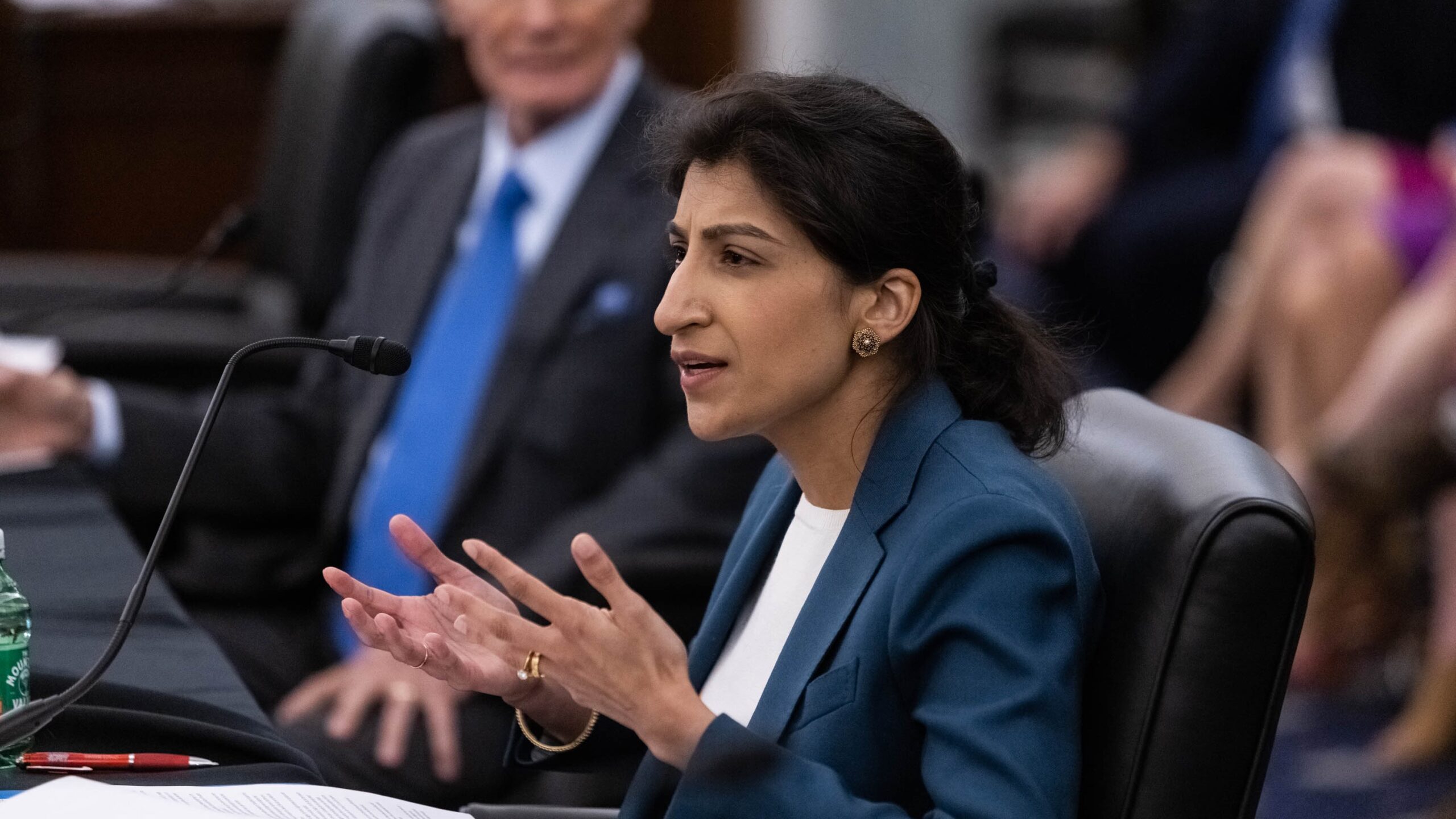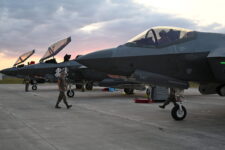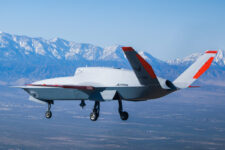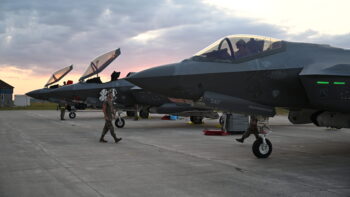
FTC Commissioner Lina M. Khan has proven skeptical of merger efforts. (Graeme Jennings-Pool/Getty Images)
Since the end of the Cold War, the defense industry has been on a merger and acquisitions kick, with larger firms gorging on smaller ones with few challenges put forth from government. That may be beginning to change, argues Bill Greenwalt of the American Enterprise Institute, and if so it would herald a new era for industry — with potential rewards for taxpayers.
In 1993, Secretary of Defense William Perry held a historic meeting that came to be known as the “Last Supper,” where corporate CEOs were given a clear mandate: the Cold War is over, and defense firms will need to consolidate or die.
Industry got the message, and commercial companies subsequently sold off their compartmentalized defense units resulting in a limited number of specialized defense primes that now dominate most defense programs. As analyst Pierre Chao once observed, 107 defense contractors became five. But that was hardly the end of the contraction in industry, with major players such as L3 and Harris or Raytheon and United Technologies combining in recent years.
It led to a belief that M&A activity will continue unabated for years to come. But two major changes in the last year are sending a different signal, one industry needs to wake up to, or face the consequences.
The first change comes from the government. Under the Biden administration, there has been true Federal Trade Commission (FTC) pushback towards M&A for the first time in recent history. If CEOs of the major defense firms didn’t get the message from January’s FTC legal action that brought down the proposed Aerojet-Lockheed merger, they now have no choice but to recognize that the FTC’s reconsideration of Northrop’s merger with Orbital ATK is the closing chapter on defense consolidation. This merger was completed over four years ago and yet it is now reported that the FTC may be looking to potentially unwind it.
While such a forced divestiture would likely face an uphill legal battle — and Northrop has signaled to investors it is not concerned — there is a huge signal being sent by the Biden administration: not only is the government skeptical of ongoing consolidation, it is not happy with the execution of those promises made in the past.
Governments can change, of course and it is entirely possible a Republican White House in 2025 would be more open to M&A activity. But the market itself is shifting, with a variety of inputs from the real threats of global conflict, inflation, supply chain, and labor shortages.
Thanks to Ukraine, the traditional defense industry will have its hands full in the future. It is now being called upon to ramp up production on existing weapon systems at a scale heretofore unimaginable, to first replace US stocks going to Ukraine and other frontline states and then to prepare for longer conflicts in the future. The industry should benefit handsomely from this doubling down on the production and maintenance of these systems. The reality though is this will require all of current management’s attention, focus, and resources to actually deliver on this production windfall in the face of ongoing market disruptions.
If industry is stretching itself to keep up with present demand, imaging the stresses needed if the US were to go to war with China or Russia. Now, imagine all of the production lines in the US being consolidated further, with fewer points of failure (whether through accident or sabotage), with fewer needs to be competitive with pricing and speed. For the US to prepare for a global conflict, it needs more, not fewer, production options. Consolidation simply flies in the face of that reality.
How The Arsenal Of Democracy Was Put To Sleep
How did it get to this? Point fingers at the government and Congress, as for decades they discounted the prospects of a great power conflict and disincentivized the defense industry from being thought of anything more than just a source of jobs for member districts. In the process, defense companies developed an unhealthy dependency on government spending and direction, and little appetite for risk.
Let’s look at history. The weapons industry has been shaped by three major shifts in the last century. In the 1920s and 1930s, a US defense industry didn’t really exist. The military was supplied by government owned arsenals and the nascent aircraft industry was being kept alive after World War I by US Postal Service contracts. The first big shift began with the Lend Lease Act of 1941. The subsequent ramping up of the Arsenal of Democracy during World War II relied upon the conversion of the dominant commercial industrial capacity of the day (primarily in the auto and steel industries) to support defense needs. The private sector was now the major player in defense. Large defense budgets as a percentage of GDP, civil-military integration of the industrial base, and the development of a dedicated research and development enterprise that supported both the military and the commercial sectors defined the early phase of the Cold War. This was the golden era of US defense innovation, but it didn’t last long – a couple of decades at most.
The next phase began in the 1960s with the decoupling of the defense industry from the civilian economy. Unique government practices and compliance requirements led commercial companies to create specific defense units that specialized in dealing with the government. The passage of the Truth in Negotiations Act in 1962 and the subsequent creation of the Cost Accounting Standards were important tools to achieve this breakdown in civil military integration but new budget (PPBE) and acquisition processes ultimately completed the defense sector’s separation from the rest of the economy. A system of privately run but still competitive government directed arsenals subsequently arose in reaction to DOD’s new unique rule set. This construct lasted for three decades and was dominated by centralized oversight and regulation and a growing arms control culture that limited innovation in an attempt to manage the technology competition with the Soviet Union.
Then came the Last Supper. While de-regulation and de-control was a complementary aspect of the Perry reforms, this never filtered down to the traditional defense industry. As a result, the US for the last three decades been burdened with the worst of all possible worlds – heavy centralized control over a small number of monopoly providers who were never incentivized to innovate beyond marginal changes to the status quo.
FTC decisions and the response to Ukraine may indicate that we are on the cusp of a 4th major shift that could shape a new defense industry. If so, the government has the opportunity to expand its reach to the multitude of sources beyond the current traditional defense industry.
If it wants more competition and innovation, DoD will need to create new opportunities for these outsiders to bid on and win defense contracts. Competition will not come by the FTC trying to force divestitures but through the effective solicitation of mission solutions (not necessarily just programs), de-regulation of acquisition rules, and the strategic picking of winners and losers which has become anathema in the government today. Companies that are now emerging through venture capital and private equity investment, large commercial firms not currently in the defense market, established players in the government services sector, foreign owned companies operating in the US, and mid-size and smaller companies incentivized to grow larger could form the basis for a new renaissance in defense competition and innovation.
Whatever industrial base construct does eventually result should depend on clear eyed DOD decision-making about future capacity and innovation needs, but at the moment there appears to be little focus on the future shape of industry in the halls of the Pentagon or in Congress. Not having a confirmed Assistant Secretary of Defense for Industrial Base Policy 19 months into a new administration is probably not helping matters. Still, change is coming whether one is proactive or not.
If the government wants industrial changes that can meet growing threats it will need to act and act forcefully. It will need to have the courage and foresight of an Eisenhower to create companies out of thin air such as when Simon Ramo was plucked out of Hughes Aircraft to found TRW and given a contract to manage the ICBM program. DoD will need to radically shift course if it wants more than just existing systems or marginally more production capacity. There is no sign of any of that happening yet.
The age of defense industrial consolidation appears to be heading for its end. What will replace this three-decade trend of creating ever larger defense unique giants through mergers and acquisitions remains to be seen.
Bill Greenwalt, long the top Republican acquisition policy expert on the SASC, also served as deputy defense undersecretary for industrial policy. A member of the Breaking Defense Board of Contributors, he’s now a fellow at the American Enterprise Institute.






















